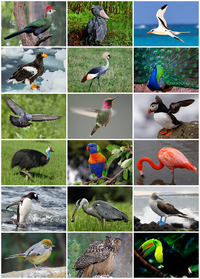
Photo from wikipedia
Humans perceive speech as being relatively stable despite acoustic variation caused by vocal tract (VT) differences between speakers. Humans use perceptual 'vocal tract normalisation' (VTN) and other processes to achieve… Click to show full abstract
Humans perceive speech as being relatively stable despite acoustic variation caused by vocal tract (VT) differences between speakers. Humans use perceptual 'vocal tract normalisation' (VTN) and other processes to achieve this stability. Similarity in vocal apparatus/acoustics between birds and humans means that birds might also experience VT variation. This has the potential to impede bird communication. No known studies have explicitly examined this, but a number of studies show perceptual stability or 'perceptual constancy' in birds similar to that seen in humans when dealing with VT variation. This review explores similarities between birds and humans and concludes that birds show sufficient evidence of perceptual constancy to warrant further research in this area. Future work should 1) quantify the multiple sources of variation in bird vocalisations, including, but not limited to VT variations, 2) determine whether vocalisations are perniciously disrupted by any of these and 3) investigate how birds reduce variation to maintain perceptual constancy and perceptual efficiency.
Journal Title: Behavioural Processes
Year Published: 2019
Link to full text (if available)
Share on Social Media: Sign Up to like & get
recommendations!